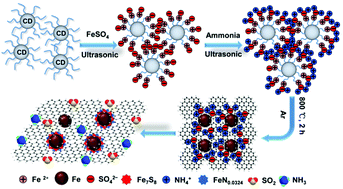High reaction activity enables carbon dots to construct multicomponent nanocomposites with superior catalytic performance†
Abstract
Multiphase nanocomposites can be employed in powerful bottom-up design strategies for achieving advanced architectures with superior properties and multiple functionalities, but their disadvantages are that they are intricate, with costly and stringent preparation processes. Herein, we report a simple and universal method for the synthesis of multicomponent nanocomposites by means of the high affinity for metal ions and strong reduction activity of carbon dots (CDs). The nanocomposite FeNS@PC, consisting of Fe cores surrounded by the shells of Fe7S8 and FeN0.0324, can be produced on a porous carbon matrix stemming from CD splicing via simple pyrolysis. Thus, CDs act as reducing agents and also are confined where the nucleation reaction occurs, thus avoiding nanophase aggregation. By harmonious interaction with all components, FeNS@PC exhibited superior catalytic performance in activating hydrogen peroxide and persulfate into reactive HO and SO4 radicals, which are the dominant active species for decomposing the pollutant tetracycline. Therefore, this work highly broadens the utilization of CD-mediated strategies for the future precise construction of novel catalysts and nanocomposite fabrication.



 Please wait while we load your content...
Please wait while we load your content...